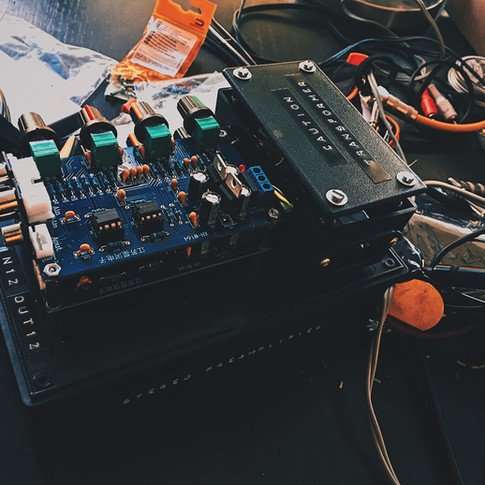Need for a piezo preamp - Part I
- cerraxca
- Aug 2, 2018
- 3 min read
A little blog post to do an update about recent works_
I’ve always been passionate about contact mics and piezo, but the biggest problem with them is that you need to reduce their impedance enough to be able to make them function pretty well. And that is true especially for the most common piezo miss and cheapest contact mics that you can built by your own.
I have a pair of Cortado contact mics and they're pretty awesome. I bought them a couple of years ago with the DIY-kit option and it's been really easy to build them. They came with a small pcb amplifier cuircuit and its components to solder onto, a small Altoids-like box where to put it and, most important, a balanced connector (XLR). They sound good to, but having also some other contacts mics that would have need an impedance solution to match with classical A/D converter and preamp inputs of my audio interface, I would like to build something that could be a both an interesting project and a practical solution for all of them.
Talking about contact microphone the major importance is given to chain of impedance, from low to high, starting from the input and going to the output.
You have to respect it, no matter what. If you put your piezos (whose impedance its about 1MΩ) into a standard line input (impedance around 50KΩ) the result will be an audio signal with an hipass filter around 200Hz. If the input is a microphone one (impedance around 1.5KΩ), the signal will have an hipass around 1K...In these cases the result will be a crappy telephone-like sound with a huge hi-pass filter effect on it (that could be also a good thing in particular situations, but not in all of them)_
"Piezoelectric elements are capacitive, which means their impedance is inversely proportional to frequency. The lower the frequency, the higher their impedance (impedance calculator). This typically results in an attenuation of lower frequencies when the contact mic is plugged into a preamplifier, which explains the characteristic “tinny” sound that many listeners experience. The piezo element actually has a wide frequency response, but the bass is rolled off in most circuits and this is exacerbated by the resonant peaks" (LOM Audio)
An impedance converter is the solution (as clearly explained on LOM Audio site). The active version of it is basically a signal amplifier made from a FET, a vacuum tube or a op-amps (my choice here, only because of the easiness to buy them everywhere). I've not chosen the passive solution because it's true that it has lower noise, but with no amplification and basically only a transformer, the signal amplitude drops. Having already not so high amplitudes for the personal application of the contact mics I didn't want to drop them to too low levels.
I link some great articles a hundred times more precise and explanatory than my poor words that coud help you to understand more in deep the topic: • https://www.gollihurmusic.com/faq/30-OHMS_AND_IMPEDANCE_FROM_THE_INPUT_PERSPECTIVE.html
• http://www.richardmudhar.com/using-piezo-contact-mics-right/
• http://www.openmusiclabs.com/learning/sensors/piezos/index.html
• http://maaheli.ee/main/building-contact-microphones/
• http://knowledge.lom.audio/research/contact_mics
FIRST_PART_OF_THE_STORY_

First path: Amazon. The easiest way to find some inspirations and crappy things. Found a pair of chinese pre-soldered preamp circuits (here the link to one of them). Try to order a couple of them, but then I’ve realised that there wasn’t all the component of the power circuitry. So I searched for a “dual” current transformer (I'm not really a grade expert in electronics, but I think it’s called like that). I needed a +12V -12V GND input for those preamps (here the link to one of them).
Got it, assembled it with the rest of the circuits, bought a pretty enclosure to fix all the components in for an easier future transportation_
Two of them make a 4 channel preamplifier (who knows if you'll need not 2, but 4 channels to pre-amplify!).
END_1: They work, they work pretty well, but... They're not designed to be preamps for ultra high-impedance piezos microphones.
First of all they were not design to be mics preamp (a maximum gain of something around 24dB), I know it.
The input/output doesn't match so well the usage with piezos and even though the sound isn't bad at all, I thought there could be something better...
Moreover they’re not so optimised on the I/O connections for my personal needs (input: dual RCA, output: 3-pin dupont connectors for L-R-Shield). I've given them a try and they're just an ok solution to match a little more from nothing an ultra high impedance.
N.B. This one is called "I'm not a Bomb 2" because this is my first attempt chronologically to do a preamp and the one I'm working on now is my second one, but the latter is smaller and more powerfull so will be my first choice if all goes well).
Here below some photos of the project_
I’m currently looking for something a little bit more “hard-core”, so I’m currently bulding another one_
Update soon_










Comments